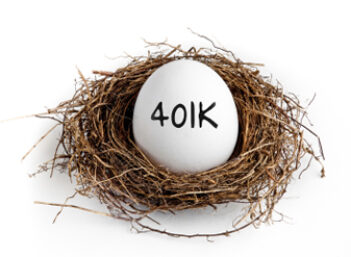Are you a freelancing journalist? Maybe you own and run your own carpentry business, or moonlight as a gardener on the weekends. Whatever you do, if you're a part-timer, independent contractor, small entrepreneur, or generally self-employed in any capacity, you're most likely eligible to enroll in one of the many self-employed retirement plans that offer enormous tax benefits.One of the many benefits of being self-employed is that there are more retirement plans available to you than there are to most taxpayers. In addition to the standard choice of traditional IRA vs. Roth IRA, you have four more plans to choose from:
1) SIMPLE Individual Retirement Account (IRA) Simplified Employee Pension (SEP) Plan
3) Solo 401(k) Plan
4) Personal Defined Benefit Plan
If you have no employees (other than your spouse), then the key issue you need to consider is the plan's contribution limit. Of course, if you do have employees, talking with a financial planner can help you navigate the more subtle distinctions between the plans, and help you decide what's best for your company.
Otherwise, each of the retirement plans generally works the same way. Contributions made to the plan are tax-deductible and your investments grow tax-free until you start making withdrawals from the plan. Now that we've covered the basics, let's take a closer look at your options.

Option 1: SIMPLE Individual Retirement Account (IRA)
Best suited for: Younger individuals with a long time to grow their nest egg; people earning less than $72,709 in net self-employment income; individuals who want an easy-to-manage fund.
Yes, a SIMPLE IRA is very simple, but its name is actually an acronym for Savings Incentive Match Plan for Employees. It's designed for a small employer with a maximum of 100 employees who earned $5,000 or more on the payroll for the previous calendar year. However, the plan is also well suited for much smaller companies, with only 10 people, or even just a one-man show. It's easy and inexpensive to set up, with no annual reporting requirements.
With a SIMPLE IRA you can contribute (for 2010) 100% of your net earnings, up to $11,500 (or if you're age 50 or older, up to $14,000). Once you've added money to the plan, you have all the investing options of a traditional IRA,
Although you can potentially sock away the entirety of your net earnings for the year, if you have any doubt that you'll be able to keep your hand out of the cookie jar, you should refrain from making the maximum contribution. Like all retirement plans, there are penalties for making early withdrawals, but in the case of the SIMPLE IRA, the consequences can be bigger. If you make an early withdrawal within two years of the plan's inception, you'll be hit with a 25% penalty. After the first two years, the penalties revert back to the standard 10%.
Option 2: Simplified Employee Pension (SEP) Plan
Best suited for: Individuals earning more than $72,709 in net self-employment income; individuals who want an easy-to-manage fund.
If your income from self-employment is more than $72,709, a SEP is a good choice. If you're newly employed, it's an even better option. Why? Because a SEP allows you to make larger contributions, kick-starting your retirement plan.
If you're newly self-employed, a SEP is a great choice. After opening a SEP, you can later graduate to a more robust option, like a defined benefit plan, or self-employed 401(k). As with the plan mentioned above, the biggest enticement of a SEP is as its name implies: It's simple. The IRS treats a SEP just as if it were an IRA, which means the paperwork to set one up is minimal. Another bonus: No tax filing required.
Annual contributions to a SEP are discretionary; if you're hurting for cash one year and need to cut back, you're free to do so. Moreover, SEP contribution limits are relatively high. For 2010, you can contribute 25% of your net earnings from self-employment, up to $49,000 -- which is ample for most people.
Because a SEP allows you to make larger contributions, effectively jump-starting your retirement savings, it's a great choice for individuals making more than $72,709. Why $72,709? That's the break-even income level for a SIMPLE plan vs. SEP plan. An individual making a net self-employment income of $72,709 will be able to contribute $13,514 to their retirement plan with either plan (after paying the self-employment tax and 'matching' contributions). Therefore, if you're earning less than that amount, a SIMPLE plan will allow you to make the highest contributions; if you're making more, a SEP plan will allow the highest.
Option 3: Self-employed 401(k)
Best suited for: Business owners with no employees (other than their spouse); individuals looking for high contribution limits.
Also known as a solo 401(k), this alternative involves more paperwork and is more expensive to set-up than the two previous options. This plan is limited to self-employed business owners with no employees other than a spouse. The major benefit: You get to make two contributions -- one as an employee, and one as an employer. The result is a total contribution limit of $49,000.
Option 4: Personal Defined-Benefit plan.
Best suited for: Self-employed individuals nearing retirement; aggressive savers who will contribute over $80,000 annually.
Compared to a SEP or solo 401(k), a defined-benefit plan is the turbo-charged retirement alternative. With it, you can shelter hundreds of thousands of dollars from taxes. Employers can save a maximum of $195,000 per year, which makes a defined-benefit plan a great choice for highly paid people who make substantial amounts of money on the side.
The contribution limit for this plan is a little different than the others; individuals can contribute 100% of their average self-employment earnings for their highest three consecutive calendar years, up to $195,000.
Out of all of the options, the personal defined-benefit plan offers the largest potential for tax-deferred growth. The drawback is that it's also the most expensive option, and is particularly complex. IRS rules require you to retain the services of a full-fledged actuary to set up the plan, which is an additional cost. In addition, the plan requires considerable annual paperwork and tax filings, all of which incur annual fees.
With a personal defined-benefit plan, you target a desired level of retirement income and then save aggressively to get there. When you establish this plan, you're required to determine how much income it will produce for you once you've retired. From that point on, you have to contribute enough money to reach that goal. This means that, depending on how the plan is structured, you might have to make contributions in years when your self-employment income is lagging.
However, if you're lucky enough to be making up to six figures on the side, then the defined-benefit plan is the way to go.
Remember, it's always important to sit down with a tax advisor or financial planner before making any major decisions regarding your hard-earned nest egg.



